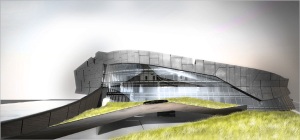
Thom Mayne’s design for a corporate headquarters in Shanghai. (Courtesy of Morphosis)
Four months ago the architect Daniel Libeskind declared publicly that architects should think long and hard before working in China, adding, “I won’t work for totalitarian regimes.” His remarks raised hackles in his profession, with some architects accusing him of hypocrisy because his own firm had recently broken ground on a project in Hong Kong.
Since then, however, Mr. Libeskind’s speech, delivered at a real estate and planning event in Belfast, Northern Ireland, has reanimated a decades-old debate among architects over the ethics of working in countries with repressive leaders or shaky records on human rights.
With a growing number of prominent architects designing buildings in places like China, Iran, Abu Dhabi and Dubai, where development has exploded as civic freedoms or exploitation of migrant labor have come under greater scrutiny, the issue has inched back into the spotlight.
Debate abounds on architecture blogs, and human rights groups are pressing architects to be mindful of a government’s politics and labor conditions in accepting commissions.
The ideological issue is as old as architecture itself. By designing high-profile buildings that bolster the profile of a powerful client, do architects implicitly sanction the client’s actions or collaborate in symbolic mythmaking?
Or in the long run does architecture transcend politics and ideology? If the architect’s own vision is progressive, can architecture be a vehicle for positive change?
For the most part, the issue is not a concrete one for the field’s top practitioners; no architect interviewed for this article except Mr. Libeskind has publicly rejected the notion of working for hot-button countries. Yet the debate underscores the complex decisions that go into designing architecture — from the basic financial imperatives, to public access, to the larger message that a building sends — and is prodding architects to reflect on their priorities.
“It’s complicated,” said Thom Mayne, the Los Angeles architect, whose projects include a corporate headquarters in Shanghai. “Architecture is a negotiated art and it’s highly political, and if you want to make buildings there is diplomacy required.”
“I’ve always been interested in an architecture of resistance — architecture that has some power over the way we live,” added Mr. Mayne, who said he had recently been interviewed for projects in Abu Dhabi, Kazakhstan, Russia, the Middle East and Indonesia. “Working under adversarial conditions could be seen as a plus because you’re offering alternatives. Still there are situations that make you ask the questions: ‘Do I want to be a part of this?’ “…
Some architects argue that architecture is more important to them than politics. “I’m a guy who has on my wall a picture of the guy in front of the tank,” said Eric Owen Moss, a Los Angeles architect, referring to the famous photograph from the Tiananmen Square protests of 1989. “But I’ve never turned down a project in Russia and China”…
Architects like Steven Holl cast their decision to build in China as a way of promoting a connection between East and West. “Certainly I question working anywhere,” Mr. Holl said. “But my position as an architect is to work in the spirit of international civilization and cooperation. You have to make a contribution.”
He cited his two-million-square-foot Linked Hybrid housing complex in Beijing, which will be heated and cooled by a 660-well geothermal energy system. “We are making the largest green total community in the history of Beijing,” Mr. Holl said. “This is an example for many kinds of urban work.”
Others go even further, arguing that their projects will be an emphatic force for social change. The Swiss architect Jacques Herzog has asserted that by supplying acres of public park space to city dwellers in the long term, his Olympic stadium in Beijing, designed with his partner, Pierre de Meuron, “will change radically — transform — the society.”
“Engagement is the best way of moving in the right direction,” he said.
Robin Pogrebin
New York Times
1 σχόλιο:
Nanokeratin locks onto the hair, forming a fine, smooth coat of keratin.
Habits die hard and whatever your regime has been in the past,
you do need to have a good look around at what is on offer
for different hair types and textures. It is designed for professionals so you
know you're getting top performance.
my homepage; hair products
Δημοσίευση σχολίου